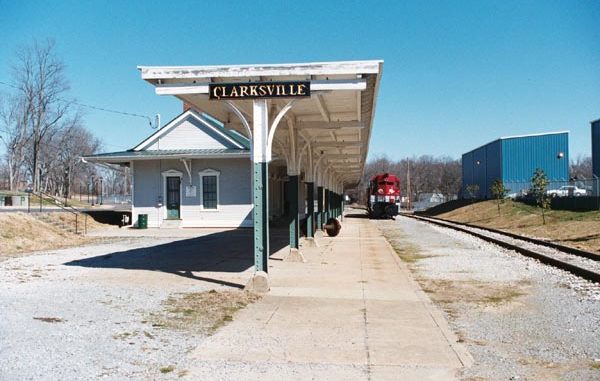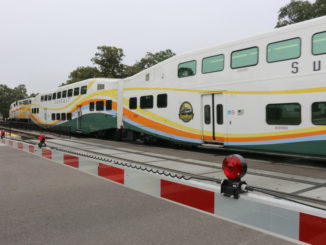
CLARKSVILLE, Tenn. — When the money ran out on the Memphis, Clarksville & Louisville Railroad, employees refused to work and a nearly two-week strike began on Feb. 6, 1868.
The Memphis, Clarksville & Louisville Railroad was chartered on Jan. 28, 1852, and ran from Paris, Tenn., to Guthrie, Ky. The road connected with two other routes — the Memphis & Ohio Railroad and the Louisville & Nashville Railroad — to provide rail service from Memphis to Louisville.
The tracks were laid on the eve of the civil war and the first train rolled down the line from Clarksville to the Tennessee-Kentucky state line on Oct. 1, 1859, according to newspaper accounts of the time. Laying tracks between Clarksville and Paris began on Oct. 24, 1860, and construction was completed on March 21, 1861. However, a bridge crossing the Tennessee River, west of Dover, wasn’t yet finished and by the time trains running between Memphis and Guthrie were operational, the Civil War had started.
After a five-year lull, post-war train service resumed Aug. 13, 1866. However, by 1867 both the Memphis & Ohio Railroad and the Memphis, Clarksville & Louisville Railroad were on the verge of bankruptcy after they defaulted on their state bonds. Salaries and bills went unpaid, eventually leaving the railroads unable to operate.
On Feb. 6, 1868, trains on the Memphis, Clarksville & Louisville stopped operating “due to an unwillingness on the part of its employees to work without being paid,” historian Kincaid Herr noted in his 1960 chronicle of The Louisville & Nashville Railroad.
For 11 days, the Memphis, Clarksville & Louisville Railroad was dormant and trains were rerouted via the Nashville & McKenzie and the Nashville & Northwestern railroads. The Clarksville Chronicle on Feb. 21, 1868, printed a statement from then-Tennessee Governor William G. Brownlow, who opposed the railroad’s strike.
“I regard to the whole affair as a regular conspiracy against the State authorities and the road,” the Governor said. “I do not propose to yield to the mob spirit of any combination, monstrating to these men that the State can do as well without the advantages of the road, as the employees can without the employment, or the citizens without the active operations of the road through its disloyal territory.”
The newspaper condemned the governor, whom it referred to as the “imp of darkness,” for his remarks, calling them a “slander against the men who are superiors in his everything.”
“(The governor) professes to see it in a huge rebellion against the State and his imperial power and scruples not to charge said strike upon our citizens and the rebellious district through which the road runs,” the paper said. “The charge is grossly false and as malicious as it false. – Petty tyrants see rebellion in every manifestation of private or public virtue; it is the result conscious guilt which makes cowards of the boldest.”
Instead of selling the road to the larger Louisville & Nashville Railroad, the Memphis, Clarksville & Louisville Railroad sought to lease the company. That action essentially extended the life of the railroad by about three years.
“Some Memphis merchants continued to fear that L&N domination would result in commercial discrimination against their city,” wrote Historian Maury Klein in his 1972 history of the Louisville & Nashville.
“Goaded mainly by public clamor over this anxiety, the Clarksville rejected every L&N overture and vowed to operate the road free of outside control. While this stance met with popular approval, it led to financial disaster. The Clarksville lacked any resources to rehabilitate its line, and earnings failed to pay even operating expenses.”
When the Louisville & Nashville Railroad leased the Memphis, Clarksville & Louisville Railroad in 1868, it not only supported it financially, it helped improve its infrastructure — including its 86 miles of track. Despite the improvements, however, the Memphis, Clarksville & Louisville Railroad wasn’t able to operate self-sufficiently and finally folded on Sept. 30, 1871.
The Louisville & Nashville Railroad later merged with the Nashville, Chattanooga & St. Louis Railway on Aug. 30, 1957. In 1972, the railroad was incorporated into the Family Lines, which ultimately folded into CSX on July 1, 1986.
CSX today operates the former Louisville & Nashville Railroad, which runs through Guthrie, Ky. R.J. Corman, a short line based in Nicholasville, Ky., operates a section — from Cumberland City, Tenn., to Guthrie, Ky. — of the Memphis, Clarksville & Louisville Railroad’s former main line.
Published in the January 2003 edition of The Cross-Tie.





